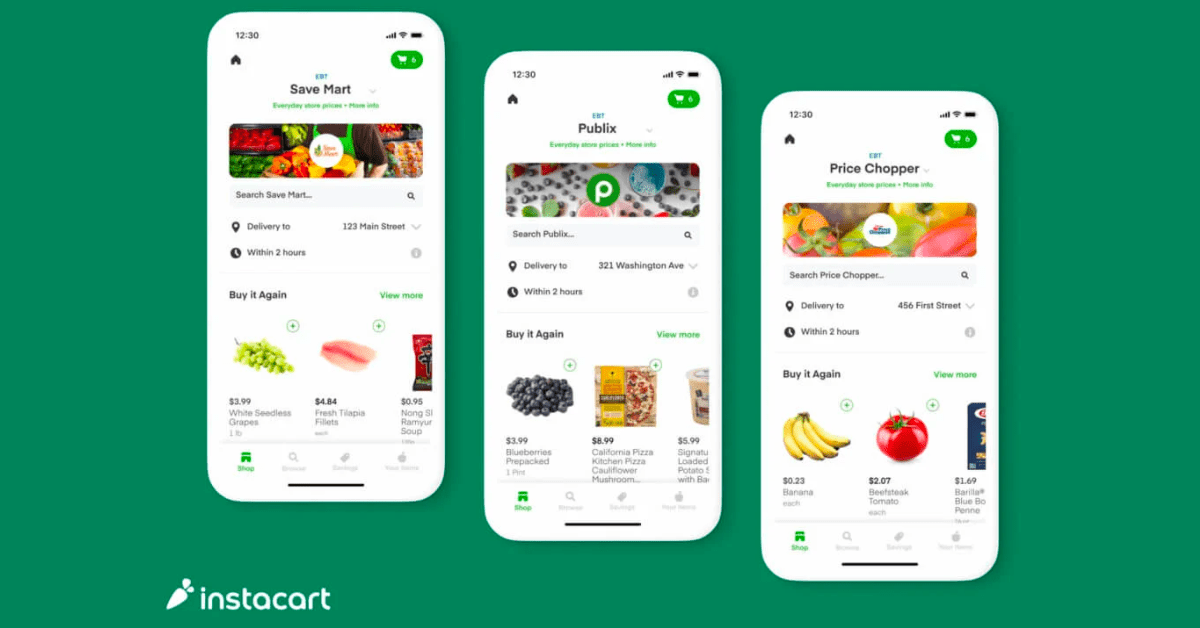
Over the past few years, consumers have increasingly welcomed the ease and convenience of having groceries delivered right to their doors. And while many grocery delivery apps have popped up in the space, Instacart remains many consumers’ go-to. Case in point: according to recent studies, as ecommerce delivery grew 77% from 2019 to 2021, Instacart accounted for 17% of that growth from 2020-21.
And now that the demand for online grocery delivery seems here to stay, Instacart is working more closely than ever before with brands of all sizes to reach online shoppers who are browsing the digital shelf the same ways they would the grocery aisles.
The Instacart Ads self-service Ads Manager launched in May 2020. It’s a fairly straightforward offering with marketers choosing which of their products they want to feature in both Instacart search results as well as in key placements throughout the app.
Even before the pandemic boom that made Instacart a billion-dollar company, Instacart had been making its name as a same-day delivery service. Today, the company partners with nearly more than 700 national, regional and local retailers to offer delivery and pickup services from more than 65,000 stores across nearly 5,500 cities in the U.S. and Canada.
What Are Instacart Ads?
Instacart ads are a version of paid search on the application where companies can pay for higher placement of their products in order to increase visibility and potential purchase opportunities from consumers using the app.
How do Instacart Ads work?
There are four main ways to advertise with Instacart.
1) Instacart Featured Product Ads
Instacart featured products appear in shoppers’ searches based on keywords, much like similar ads at Amazon or Walmart. So if a shopper is looking for “low sodium chicken stock,” advertisers who won bids on those keywords, then created ads for the product will appear at the top of search results.
Featured product Instacart ads are sold based on a cost-per-click (CPC) model with no minimum bid. And, of course, featured product ads aren’t sold for retailers that don’t carry the product. But because these ads are served based on geographic availability and stock levels, they can be an excellent way to reach local customers, especially for seasonal items.
2) Instacart Non-search Ads
Non-search Instacart ads appear elsewhere across shoppers’ experience, including the Instacart home page, different departments of a retailer’s page, the “Buy It Again” section, and even on competitors’ item pages. Instacart also offers the option to purchase a hero banner, which is placed above search results, much like a traditional banner ad.
And while much of marketers’ focus is often centered around winning keyword bids, these display ad campaigns shouldn’t necessarily be dismissed as ineffective. In fact, according to a recent study out of Stanford, shoppers who encountered a display ad campaign, such as a hero banner, made 5-25% more campaign-related searches than shoppers who didn’t.
3) Instacart Coupons
Instacart also offers options for building campaigns around specials and promotions. The platform gives brands the option to run coupons through Instacart itself. These coupons show up beneath search results for selected items and become invalid for 30 days following purchase. Advertisers who offer coupons through Instacart only pay for the coupons that get redeemed.
Another way Instacart allows advertisers to offer savings to customers is through delivery promotions. Research shows that nearly a quarter of shoppers (24%) are willing to spend a bit more in order to qualify for free delivery. Instacart ad campaigns can offer free delivery to shoppers who spend a certain amount in order to encourage purchases.
4) Instacart Shoppable Video and Display
The company announced new Instacart Ads formats that it would start offering shoppable video and display ads in May 2022. While both formats are still in the pilot phase and won’t be more widely available until later in 2022, Instacart promises that its video ads will enable advertisers to “fuel brand affinity with rich stories, motion and audio, and inspire bigger baskets with seamless add to cart functionality.”
Likewise, its shoppable display ads are intended to create a virtual “pop-up shop” that allows brands to “pin a bundle of items that inspires complementary purchases, innovation, and drives routine purchases.”
How to get started with Instacart Ads
First, CPG brands must register with Instacart. From there, it is fairly easy to test and explore Instacart’s CPC ads before experimenting with other ad formats, such as hero banners and coupons. Simply select the items you’d like to promote, set a budget, and stay informed of what’s working within your campaigns–along with which areas need improvement.
If you’re a CPG brand whose items appear on the Instacart app, and you’re not bumping them to the top search spots with Instacart Ads, you could be missing out on a vital way to connect with new customers and brand loyalists alike!
Skai’s Retail Media solution for Instacart plus over 30 more retailers
As part of Skai’s omnichannel marketing platform, our Retail Media solution empowers brands to plan, execute, and measure digital campaigns that meet consumers when and where they shop. Built with best-in-class automation and optimization capabilities, our unified platform allows you to manage campaigns on 30+ retailers including Amazon, Walmart, Target, and Instacart all in one place.
Schedule a brief demo today to see how Skai can help you maximize your Instacart Ads (and other retail media) investments.